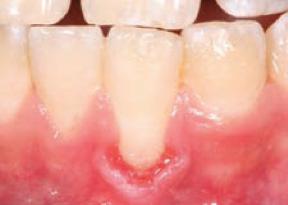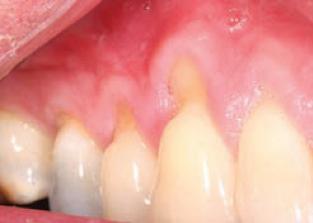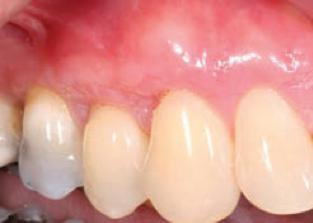GUM RECESSION: CAUSES AND TREATMENTS
When your teeth are healthy, your gum tissue tightly hugs each of your teeth. But, when your gums pull away from your teeth, it is called gum recession (re-SESH-un). Gum recession can happen at any age.
Even if you take good care of your teeth, it is possible that gum recession may still happen.
Gum recession can cause problems for your teeth. Your dentist can help you understand what is causing it to happen and suggest a treatment.
Gum recession can leave the tooth root exposed. The root surface does not have a hard, protective layer covering like the top of the tooth, so it may become sensitive to hot and cold. The exposed tooth root is also more at risk for decay.
WHAT CAUSES GUM RECESSION?
- gum disease
- brushing your teeth too hard or using a toothbrush with hard bristles
- trauma to gum tissues, such as a sports injury
- partial dentures that don’t fit right
- genetics–some people are born with gums that are thin or weak
- larger-than-normal tooth roots or attachment muscles that can push gums out of place
- smoking and using any kind of tobacco

Gum recession of a tooth
TREATMENTS
It is important to treat gum recession so that it doesn’t get worse and cause other problems. The type of treatment for gum recession depends on the cause.
If gum recession is caused by brushing too hard, your dentist or hygienist can show you a better way to clean your teeth. This will not repair the existing damage, but it will prevent new damage to your gums.
If gum recession is caused by periodontal (gum) disease, the first step is usually a deep cleaning treatment called scaling (SKAY-ling) and root planing (PLAY-ning). Your dentist removes plaque and tartar from your tooth and root surfaces. This helps gum tissues heal and reattach to the tooth. For many patients, this plus excellent oral care at home and regular dental visits can help control gum disease and recession.
If gum recession is caused by partial dentures that don’t fit right, your dentist can adjust or remake them for you.
If your recession is advanced, a gum graft may be needed. A thin piece of gum tissue is taken from another place in your mouth and attached where the gum tissue has receded. Once the graft heals, it covers the exposed tooth root.
Grafts may be done around one or more teeth. They protect the tooth root from sensitivity and decay. A graft can also be used to make a smile look better.

Before gum graft

After gum graft
CARE AFTER YOUR TREATMENT
If you have a gum graft, your dentist will tell you how to care for your gums. This may include using a special mouthrinse and changing what you eat. A bandage or dressing may be placed over the graft to help it heal.
Gum grafts are a kind of surgery and the area may be tender or sore and may swell. Most people are able to go back to their normal routines the next day. However, you may need to avoid chewing for a week or two where the surgery was done. Your dentist will talk with you about your specific healing time.
To help your gums heal after surgery:
- Avoid smoking or using any kind of tobacco.
- Do not drink alcohol.
- Follow all instructions from the dental team.
There are other things that can slow down healing. These include older age, grinding your teeth, not eating a healthy diet, and some medicines or health issues. Be sure to tell your dentist about all medications, drugs, or vitamins you are taking and health issues you may have.
After your gums have healed from surgery, keep your teeth and gums healthy by brushing gently twice a day with a fluoride toothpaste. Also, be sure to clean between your teeth daily with floss or another between-the-teeth cleaner. Look for products with the American Dental Association Seal of Acceptance. These products have been tested and proven to be both safe and effective in keeping your mouth healthy.
